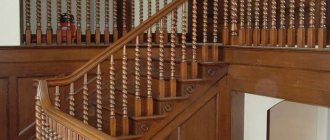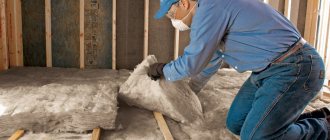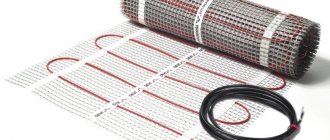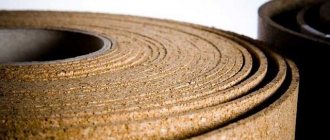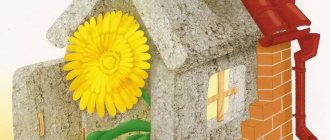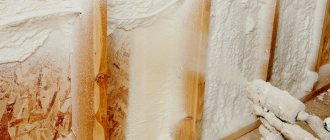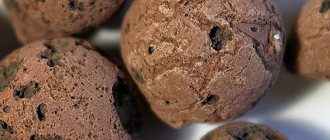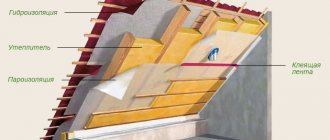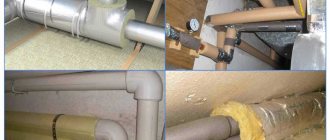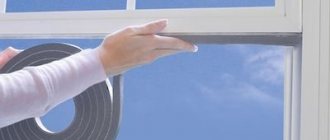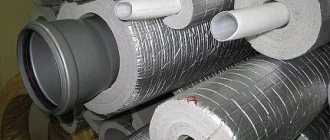Read the publication about which insulation is best to choose for installation under siding, but for now let’s talk about the rules for fixing basalt slabs.
Stone wool is a fibrous material with high insulating characteristics, due to which it perfectly retains heat and sound. To increase comfort inside the house, you simply need to correctly fix the mini-slabs on the surface. In this article we will look at how to attach basalt insulation to a wall to achieve maximum thermal insulation effect.
What it is
Low-density basalt insulation is a type of mineral wool samples, and its qualities are significantly superior to its other main classes. The product consists of melted and drawn fibers in the form of threads. Mixed in different directions, they create an airy, warm and durable product. Many air bubbles accumulate between these threads, providing an insulating, sound-absorbing, and moisture-reflecting result.
Basalt facade insulation, depending on the density and diameter of the fibers, is classified into three grades:
- soft;
- semi-rigid;
- hard.
The thickness of the cotton wool threads is from 1 micron to 500 microns. Basalt facade insulation is produced in the form of slabs of the following size options:
- 0.5 by 1.0 m;
- 0.6 by 1.2 m.
The thickness of the product is in the range of 5–15 cm. As external insulation for low-rise construction, facade slabs with a thickness of 10 cm are used. An analogue is also produced in rolls. Its distinctive feature is considered to be low density, which is why the material is susceptible to deformation.
How to produce
To obtain basalt fiber, the technology of melting basalt rocks is used. The temperature during such heating reaches 1500° or more. Then, using an inorganic bonding agent, the basalt fibers are woven together through the process of filtration precipitation. Vacuum treatment is used for filtration. The final phase of production is calcination and then drying of the facade insulation. The heat shock procedure is used for this.
Various technologies can be used in the production of cotton wool:
- A method of heating followed by melting of raw material rock using an electromagnetic field. This allows you to control the process (stop and start again) without wasting time or damaging the crucibles.
- Producers consume little energy - a maximum of 10 MJ per kilogram of melt produced. To perform the process, an induction version of crucible furnaces is used, which allows the use of mineral raw materials in the production of basalt wool.
Important! The output of the production process is low-density facade insulation that is resistant to deformation, elastic and easy to cut.
Other combination methods
Besides mixing cement mortar with concrete chips, there are other ways to combine concrete with foam. Moreover, when planning construction, it is worth paying attention to them.
Using ready-made sheets
Here you need to immediately make an important note - it is advisable to use extruded polystyrene foam. This material, although more expensive than foam, however, it significantly exceeds it in its performance characteristics:
- expanded polystyrene is denser;
- it has the best thermal and sound insulation performance;
- it is much more resistant to humidity.
Expanded polystyrene
A, in addition, due to its higher density, this material has a longer service life than foam plastic.
- when floors are made, polystyrene foam sheets are used for rough flooring and laid on the base;
- concrete is poured directly onto the foam.
This approach has a number of advantages:
- the screed turns out to be thin, so its final weight is reduced;
- the floors are well insulated, in addition, they have a high level of sound insulation;
- The technology of work is very simple.
Another advantage of this method appears when installing heated floors. Due to the fact that polystyrene foam does not allow heat to pass through, their efficiency increases significantly.
In addition, you can insulate the walls with foam sheets. However, this method is best used only for exterior work with subsequent finishing. If you cover the walls with foam plastic from the inside of the room, you may encounter the problem of condensation.
Creation of permanent formwork
This is another option for combining these materials. The method is that the formwork for the construction of the building structure is constructed from polystyrene foam. And then everything is reinforced and filled with cement mortar.
- strength - concrete poured with polystyrene foam turns out monolithic, which has a positive effect on the strength of buildings;
- ease of working with the material with your own hands - polystyrene foam is easy to process;
- speed – the amount of work is reduced.
In addition, the walls are well insulated. The only negative is that subsequent finishing of the facade is required.
Advantages and disadvantages
Figure 2. Installation of basalt insulation
The use of basalt for insulation as thermal insulation of facades allows you to obtain certain advantages in comparison with other insulating materials:
- Fire safety;
- durability;
- low thermal conductivity;
- energy efficiency;
- chemical resistance;
- healthy microclimate;
- acoustic comfort;
- high vapor permeability;
- resistance to microbes and rodents;
- corrosion protection.
Among the disadvantages of low-density facade insulation, the following parameters should be highlighted:
- high price;
- the presence of binding resins, which impairs the environmental friendliness of the insulation;
- vapor permeability;
- protective equipment is required for installation of insulation;
- When laying, joints are formed between the slabs.
How to choose basalt facade insulation?
When choosing thermal insulation facade insulation, you need to build on the following criteria:
- external characteristics of the product;
- density, which affects the weight of the material;
- the thickness of the roll or mats, which determines the required thermal conductivity coefficient;
- a manufacturing company that offers its own highly specialized or universal solutions that allow thermal insulation with low-density facade insulation.
Important! The main rule in facade insulation: the lower the density of the slab, the better the wool will insulate the structure. You should also take into account the architectural features, the height of the building, as well as the possibility of additional load on the base (foundation).
Subtleties of application
Low-density basalt wool is used for facade finishing, which is due both to its high moisture strength and thermal efficiency, and to the ability to significantly prevent a decrease in the internal area of the building, which inevitably occurs with internal wall cladding. Installation work should be carried out only on a dry, warm day (air temperature from +5° to +25°C), so that the humidity level does not exceed 80%. It is important that during the installation of low-density facade insulation, direct sunlight does not fall on the treated surface. Laying thermal insulation (insulation for a basalt facade) begins with preparatory work.
Loose penoizol
Penoizol flakes have a random shape.
In appearance, penoizol looks like foam chips, but if you look more closely, the difference is obvious. Despite the visual similarity, these are two completely different materials. Penoizol is more reminiscent of snow flakes, it does not have an ideal ball shape, this material is softer. Penoizol is used as fill-in insulation for walls and horizontal ceilings. In addition, it is also available in sheets, but is mainly used in liquid form. Unlike polystyrene foam, penoizol:
- does not burn;
- does not smoke;
- allows moisture to pass through, but does not absorb it.
The thermal conductivity characteristics of both materials are almost equal.
Penoizol backfill insulation for walls is made from resin. The quality of the material primarily depends on the quality of the resin used for production.
First, the liquid substance is poured into blocks, about a meter by meter. Then the blocks are cut into sheets, and only then the sheets are crumbled. Installation is carried out using a blowing machine or manually. When working, you need to control the degree of density of the material.
Preparation
Installation of insulation is carried out in two ways. These are the following technologies:
- wet facade;
- on the frame according to the type of ventilated structure.
For work, it is better to take rectangular or wedge-shaped slabs, since they are easier to join together. Preparation includes the following important points:
- removal of various communication systems, objects (nails, fittings);
- cleaning the surface from a layer of plaster and dirt;
- sealing all defects and cracks on the surface using polyurethane foam, tow, and felt;
- if there are differences in the thickness of the facade, it is necessary to adjust them using different thicknesses of low-density basalt insulation;
- priming walls against the development of mold and mildew;
- treatment with a special surface composition to increase adhesion.
Correctly completed preparatory work will help install the thermal insulation system efficiently and quickly. To complete the event, you need to prepare the following products and tools in advance:
- insulation in the form of basalt slabs or cotton wool;
- glassine;
- polyurethane foam;
- wooden slats;
- knife and construction nails;
- grinding float;
- hammer.
Advantages of polystyrene foam
One of the thinnest insulation materials
Among all insulation materials, ordinary polystyrene foam, also known as expanded polystyrene, has almost the lowest thermal conductivity coefficient. What does it mean? This means that its thickness as insulation will be the smallest compared to other materials. Here is a list of these materials in increasing order of their ability to conduct heat:
- Penoizol (50 mm).
- Foam insulation (75 mm).
- Mineral wool (125 mm).
- Wood (340 mm).
- Brick wall (900 mm).
- Concrete (2132 mm).
- the thickness of the materials at which their equality as heat insulators is achieved is indicated in brackets;
- penoizol is a liquid material that consists of several components. When they are mixed, it swells and hardens. At the same time, it acquires a porous light structure similar to hardened polyurethane foam. Its main disadvantage is toxicity. Therefore, it can only be used for insulation of non-residential premises. Usually, it is poured into a specially prepared cavity inside the wall.
The lightest insulation
Finding out the weight of polystyrene foam boards is very simple. All manufacturers indicate the density of the material on the packaging:
- 15 kg/m 3;
- 25 kg/m3;
- 35 kg/m3.
And the density of one cube is its weight. That is, one cube weighs 15, 25 and 35 kg, respectively. By the way, this is how you can check the quality of the material you buy. If the package says 25 kg/m3, and the tested package of sheets weighs less, don’t hesitate. You were a little misled.
Sometimes the manufacturer bypasses this point. For example, a package with a declared density of 25 kg/m 3 will contain sheets with a actually lower density. But this packaging will have its own beautiful name. And a pack of sheets with a real declared density will be called differently: “Warm House”, “Standard” or “What else”. But, in any case, the lighter the pack, the lower the density of the insulation. Remember this.
For work, you can use foam of any density. The main thing is to understand that the lower it is, the more fragile and fragile the sheet will be in your hands. But the use of such sheets, for example, on the first floor of a building is not recommended - the facade can easily be damaged by an impact. Therefore, the denser the sheet, the better.
One of the most inexpensive insulation materials
This is truly the most inexpensive industrial insulation material. At the same time, two types are used in construction practice:
- sheet foam;
- foam chips or balls.
Today, the selling price for both of these species is approximately equal. Most likely, this is due to an increase in demand for balls. Most often they are used for roof insulation. The cement-sand mixture is mixed with balls and poured onto the ceiling. It turns out warm, durable and inexpensive.
Polystyrene foam is a very multifunctional insulation material.
Here are its main areas of application:
- wall insulation;
- roof insulation;
- floor insulation;
- insulation of the basement of the house.
Insulating walls with foam sheets has become a classic today. The result is very warm, relatively inexpensive, quite durable and reliable. In terms of service life, polystyrene foam covered with a layer of plaster can last for a very long time. Manufacturers guarantee the service life of facades made of polystyrene foam boards without major repairs for 30 years. They say that in Germany, houses insulated with foam plastic are insured for longer periods. Up to 100 years.
Installation
The technology called “wet facade” involves the use of binders in the form of glue or solution for installation. It is recommended to use only special glue (such as Ceresit CT190).
First, a pre-prepared vapor barrier film is attached to the wall surface. After this, the following technological actions begin:
- The bars or metal profile are fixed vertically, maintaining an interval that is slightly smaller than the dimensions of the purchased basalt slabs or basalt wool roll. Low-density basalt insulation must fit inside the studs with some force, and then hold itself between them. Similarly, the thickness of the insulation should correspond to the height of the frame slats.
- The cells assembled on the façade are scrupulously filled with basalt wool. It is fastened using glue, while using additional fasteners in the form of dowels, suitable for stone or concrete facades, or self-tapping screws equipped with large washers, when the wall of the building is wooden. To firmly fix the slabs or rolls, it is necessary to use 6 hardware for each square meter.
- After fixing the insulation, a special windproof membrane is laid over it, scrupulously gluing its joints with tape.
- Before starting finishing, it is recommended to build additional sheathing on top of the insulation using thin slats. This will provide a ventilation layer.
- The final stage of construction is the cladding of the facade.
If it is planned to perform thermal insulation on the frame according to the type of ventilated structure, then the work is carried out in this order. First, a selected vapor barrier membrane is attached to the prepared base, which will allow moisture to pass through from inside the structure, preventing it from accumulating inside the basalt insulation. The film is mounted in horizontal stripes. The first is attached to the bottom of the building. Subsequent layers are laid, maintaining a ten-centimeter overlap and sealing the joints with tape.
Subsequent installation
Then you need to equip the frame. Wooden bars or galvanized profiles are used as lathing. The distance between them is affected only by the width of the purchased basalt insulation. It is recommended to reduce this step slightly to allow the wool to fit tightly between the guides.
When the insulation material is laid, a windproof membrane is attached on top of it. It is placed in a similar way to a vapor barrier film. Overlapping and gluing all joints with mechanical fasteners (umbrella dowels) is definitely required. Such fastening will allow you to hold the material - it will not be able to slide. Lastly, the counter-lattice is attached to create a ventilation gap on the façade.
Wall insulation process
The technology for insulating surfaces using basalt wool is simple, does not require special expensive equipment and is quite within the capabilities of a home craftsman with general construction skills.
How to prepare and attach basalt slab insulation to an external wall
Thermal insulation of external walls begins with the installation of a cornice at the foundation level.
Next, install the sheathing. Its elements must be spaced apart so that the plates fit between them with some force, ensuring good clamping and compaction. This is especially important for insulating ceilings and walls.
The next step is to attach the basalt insulation, intended for the external walls of the house, to the outside using polymer cement glue. The glue is spread with a spatula in an even layer on the slab and pressed against the wall. The recommended direction for laying slabs is from bottom to top and from right to left. First, whole slabs are attached, then they begin to cut out strips to fill the remaining gaps.
Installation of slabs in sheathing
Installation of external insulation is completed by leveling the surface with a sanding float.
Roof insulation
First, the surface is cleaned and leveled, and the sheathing is installed. An existing rafter system can be used if the rafter spacing matches the width of the slabs.
Next, a layer of vapor and wind barrier film is laid and secured, protecting the basalt wool from condensation that accumulates on the inside of the roof during temperature changes. It is also necessary to organize natural ventilation of the space under the roof. To do this, special elements are installed on the roof - vents.
Installation of 100 mm slabs between rafters
Instead of a special film like Izover, it is permissible to use foil or glassine. The vapor barrier is secured with staples or double-sided tape.
Vertical elements and slabs located on the ceiling are secured with self-tapping screws through special dowels with a support platform. It is allowed to fasten such elements using a zigzag stretched twine made of synthetic materials.
Attaching mats with twine
From an aesthetic point of view, it looks creepy, but, nevertheless, it provides fastening.
Insulation of internal walls and interior partitions
Installation on internal walls is different in that vapor barrier is not installed on them, since it is necessary to ensure the removal of water vapor and moisture from residential and domestic premises.
Working with interior walls
Before laying the insulation, it is necessary to complete the installation of all communications provided in the walls:
- wiring;
- water pipes;
- heating;
- sewerage
It is recommended that electrical wiring be laid in corrugated sleeves so that the faulty section can be changed without dismantling the wall. It is also better to secure installation boxes for switches, sockets and connections on the walls in advance.
In the places under the windows where heating radiators will be installed, foil slabs of basalt wool are laid. This improves thermal insulation and reflects the heat emitted by the radiator into the room.
When laying wool in interior partitions, thermal insulation is not so important. The task of sound insulation comes to the fore. They usually use lightweight types of insulation, whose looser fibers disperse sound waves well.
Finishing
The final finishing after the main stage of laying the insulation consists of painting the already plastered walls. For this purpose, primer paint is used. To improve adhesion between the wall surface and the paint, the plaster is treated with fine sandpaper.
The final stage will allow you to solve two problems at once: protective and decorative. More common are plastered facades, which are applied to insulation secured using the “wet” method. If the basalt wool is installed using the ventilated facade method, I cover it with siding.
general information
In construction, concrete is defined as an artificial stone that is obtained by forming and hardening a mixture of cement with water, crushed stone and sand. It has a number of advantages: good sound insulation, strength, long service life, frost resistance, but the thermal insulation characteristics of concrete are not the best. Buildings made from it are cold and require additional insulation. Foam plastic, which is a building material containing polymers, is excellent for this purpose. It is characterized by excellent moisture resistance and thermal insulation, which allows you to protect the facade of the building from the penetration of liquids, and the interior of the room from the cold.
